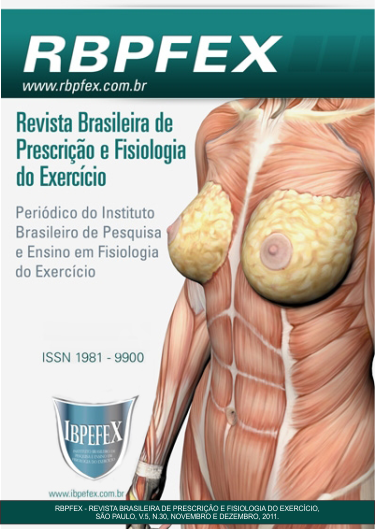Acute effect of thermoregulation on cardiovascular drift during aerobic exercise–a case study
Abstract
This laboratory study investigates the effect of cardiovascular oscillations in thermoregulation during 45 minutes of aerobic exercise at a constant speed at room temperature between 24 and 25 °C with no fluid replacement. The research objective was to analyze the behavior of body temperature, heart rate, blood lactate and blood pressure, taking into account the water loss during the race at a constant intensity (approximately 70% of anaerobic threshold speed). Thus, we selected an individual physically active, practicing triatlhon long distance for over two years, with a weekly circulation of at least three times and no associated pathology. For the data collection were two test sessions on a treadmill (0% incline). In the first session, a maximum test was done with oxygen gas analyzer equipment, heart monitor and blood lactate analyzer. In the second session, physiological changes were observed during the race for 45 minutes at a constant rate (71.4% of anaerobic threshold speed). The results show that despite having been found a linear relationship between heart rate and oxygen consumption to a certain point, the prescription of training for athletes seeking to improve performance doesn ́t have to be based in heart rate only. We conclude that even at ambient temperatures appropriate, the water loss in endurance training causes the cardiovascular system to perform major adjustments in order to maintain cardiac output.
References
-ACSM. Diretrizes do ACSM para os Testes de Esforço e sua Prescrição. 7ª Ed. Editora Guanabara. 20072-Almeida, M.B. Freqüência Cardíaca e Exercício: Uma Interpretação Baseada em Evidências. Revista Brasileira de Cineantropometria e Desempenho Humano. Vol. 9. Num. 2. 2007. p. 196-202.
-Alonso, D.O.; Forjaz, C.L.M.; Rezende, L.O.; Braga, A.M.F.W.; Barretto, A.C.P; Negrão, C.E.; Rondon, M.U.P.B. Comportamento da Freqüência Cardíaca e da sua Variabilidade Durante as Diferentes Fases do Exercício Progressivo Máximo. Arquivo Brasileiro de Cardiologia. Vol. 71. Num. 6, 1998. p. 787-792.
-Brum, P.C.; Forjaz, C.L.M; Tinucci, T.; Negrão, C.E. Adaptações Agudas e Crônicas do Exercício Físico no Sistema Cardiovascular. Revista Paulista de Educação Física. São Paulo. Vol. 18. 2004. p. 21-31.
-Charkoudian, N.; Halliwill, J.R.; Morgan, B.J.; Eisenach, J.H.; Joyner, M.J. Influences of Hydration on Post-exercise Cardiovascular Control in Humans. Journal of Physiology. Vol. 552. 2. 2003. p. 635-644.
-Coyle. E.F.; González-Alonso, J. Cardiovascular Drift During Prolonged Exercise: New Perspectives. Exercise and Sport Sciences Reviews. Vol. 29. Num. 2. April. 2001. p. 88-92.
-Farinatti, P.T.V; Assis, B.F.C.B. Estudo da Frequência Cardíaca, Pressão Arterial e Duplo-produto em Exercícios contra-resistência e Aeróbio Contínuo. Revista Brasileira de Atividade Física e Saúde. Vol. 5. Num. 2. 2000.
-González-Alonso, J.; Calbet, J.A.L.; Nielsen, B. Muscle Blood Flow is Reduced with Dehydration During Prolonged Exercise in Humans. Journal of Physiology. Num. 513. 3. 1998. p. 895-905.
-Henkin, S.D. Respostas de Sudorese de Nadadores, Corredores e Indivíduos não Treinados Após Exercício no Calor. Universidade Federal do Rio Grande do Sul. Porto Alegre, 2007.
-Leal Junior, E.C.P.; Souza, F.B.; Magini, M.; Martins, R.A.B.L. Estudo comparativo do consumo de oxigênio e limiar anaeróbio em um teste de esforço progressivo entre atletas profissionais de futebol e futsal. Revista Brasileira Medicina do Esporte. Vol. 12. Num. 6. Nov/Dez 2006. p. 324.
-Magalhães, S.; Albuquerque, R.R; Pinto, J.C.; Moreira, A.L. Termoregulação. Faculdade de Medicina do Porto. Serviço de Fisiologia. Porto, 2001/02
-Marquezi, M.L.; Lancha Junior, A.H. Estratégias de Reposição Hídrica: Revisão e Recomendações Aplicadas. Revista Paulista de Educação Física, São Paulo.Vol. 12.Num. 2. jul/dez. 1998.p. 219-227.
-Maughan, R.; Shirreffis, S. Exercise in the heat: challenges and opportunities. J. Sports Sci. Vol. 22. Num. 10. 2004. p. 917-927.
-McLellan, T.M. The importance of aerobic fitness in determining tolerance to uncompensable heat stress. Comparative Biochemistry and Physiology Part A: Molecular eIntegrative Physiology. Vol. 128. Num. 4. April, 2001. p. 691-700.
-Reis, V.M.; Tillar, R.V; Marques, M.C. Higher precision of heart rate compared with VO2 to predict exercise intensity in endurance-trained runners. Journal of Sport Science and Medicine. Num. 10. 2011. p. 164-168.
-Ribeiro, J.P.; Moraes Filho, R.S. Variabilidade da Freqüência Cardíaca como Instrumento de Investigação do Sistema Nervoso Autônomo em Condições Fisiológicas e Patológicas. Revista Hospital das Clínicas de Porto Alegre. Vol. 25.Num. 3. 2005. p. 99-106.
-Saat, M.; Tochihara, Y.; Hasgiguchi, N.; Sirisinghe, R.G.; Fujita, M. Chou, C.M. Effects of Exercise in the Heat on Thermoregulation of Japanese and Malaysian Males. Journal of Physiological Antropology and Applied Human Science. Num. 24. 2005. p. 267-275.
-Shiroma, D.M.; Santos, C.R.P.; Nunes, D.S.; Almeida, A.L.A.R. Correlação entre teste invasivo e não invasivo, verificados através do método Dmáx, para estimativa do máximo estado estável de lactato em indivíduos fisicamente ativos. Revista Brasileira de Prescrição e Fisiologia do Exercício. Vol. 3. Num. 18. Nov/Dez. 2009. p. 534-546.
-Wilmore, JH, Costill, DL. Fisiologia do Exercício. 2ªEd. Barueri-SP. Ed. Manole. 2001.
Authors who publish in this journal agree to the following terms:
- Authors retain the copyright and grant the journal the right of first publication, with work simultaneously licensed under the Creative Commons Attribution License BY-NC which allows the sharing of the work with acknowledgment of the authorship of the work and initial publication in this journal.
- Authors are authorized to enter into additional contracts separately for non-exclusive distribution of the version of the work published in this journal (eg, publishing in institutional repository or book chapter), with acknowledgment of authorship and initial publication in this journal.
- Authors are allowed and encouraged to post and distribute their work online (eg, in institutional repositories or on their personal page) at any point before or during the editorial process, as this can bring about productive change as well as increase impact and impact. citation of published work (See The Effect of Free Access).






